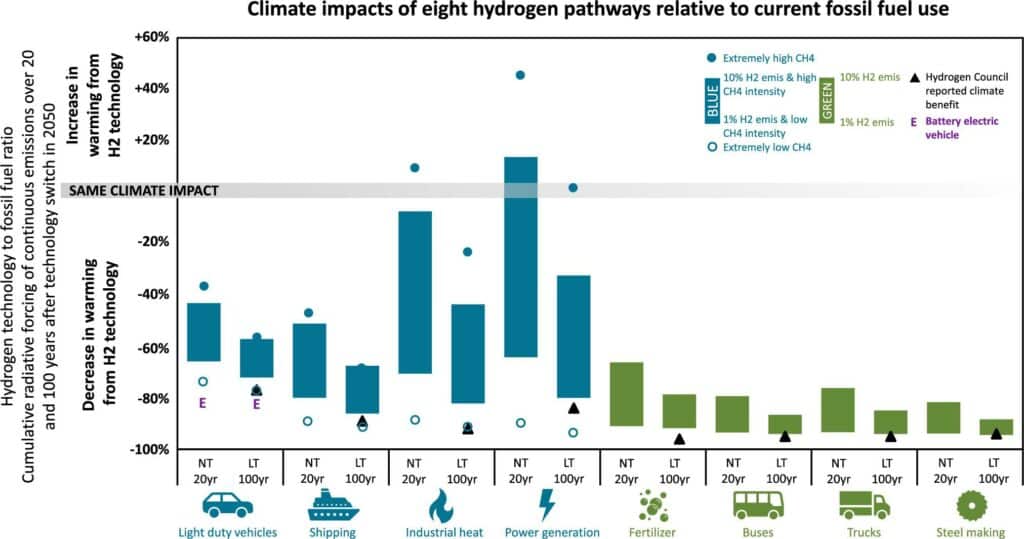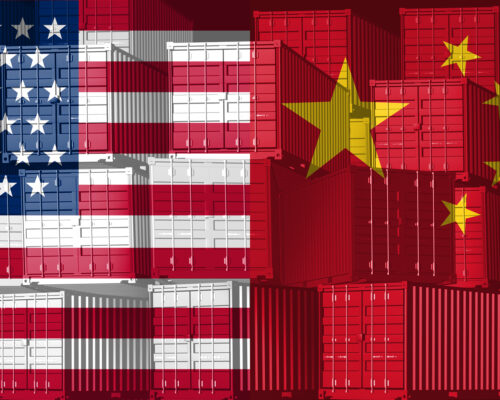Low-carbon Hydrogen Is Dangerous: But Why?
Photo: Shutterstock / Sergio Bertino
14 March 2024 – by Nithin Coca Comments (2)
A new, first-of-its-kind hydrogen life-cycle assessment from the Environmental Defense Fund (EDF) has found that low-carbon hydrogen is not climate-friendly and could be up to 50% worse than traditional fossil fuels for the climate. This is the case when all the impacts, including hydrogen and methane leakage, are taken into consideration.
“When we consider all climate warming emissions and their impacts over the near and long-term, our analysis shows that hydrogen deployment can have far greater impacts than expected,” said EDF climate scientist and lead author Tianyi Sun, in a press statement.
Now, the attention is turning to two countries at the centre of this push – Japan and South Korea. Both countries are putting the use of hydrogen, including low-carbon hydrogen, at the centre of their net-zero emissions plans. However, an increasing body of science is finding that low-carbon hydrogen may not be a viable climate solution.
What Is Low-carbon Hydrogen?
Low-carbon hydrogen, sometimes referred to as blue hydrogen, is hydrogen produced from natural gas, but in which the resulting carbon dioxide emissions are mitigated by the use of carbon capture and sequestration (CCS) technology.
Grey, Brown and Blue Hydrogen Types
This puts it in contrast to grey hydrogen, made from natural gas but without CCS, and brown hydrogen, made from coal. Currently, the vast majority of hydrogen used not only in South Korea and Japan, but globally, are the grey and brown hydrogen types.
South Korea and Japan are Pushing Low-Carbon Hydrogen Production
South Korea has plans to build a massive clean hydrogen ecosystem, which relies heavily on low-carbon hydrogen, to be used in industry, large transportation and more. Meanwhile, Japan’s Green Transformation (GX) relies heavily on low-carbon hydrogen, and the country is already piloting hydrogen shipments after opening the world’s first liquefied hydrogen receiving terminal in 2020. Meanwhile, South Korea received the world’s first commercial shipment of low-carbon hydrogen in 2022.
While these plans are being pushed as climate-friendly, EDF’s report shows that the reality is far different.

The Problem with Carbon Capture and CCUS Hydrogen
At the core of low-carbon hydrogen is a reliance on CCS. The fossil fuel industry often uses the term CCUS, which stands for carbon capture, utilisation and storage, rather than CCS.
The benefits of carbon capture technology are largely unproven. Meanwhile, most projects are located alongside oil and gas fields, where CCS is used to increase fossil fuel production by injecting CO2 into difficult or hard-to-tap fields. It’s notable that the main sources of low-carbon hydrogen for Japan and South Korea are countries like Qatar, Australia and Saudi Arabia, provided by oil and gas companies like Saudi Aramco.
“The reality is, blue hydrogen is not clean or low-carbon,” said David Schlissel, the director of resource planning analysis at the Institute for Energy Economics and Financial Analysis (IEEFA), in a press statement. “Pursuing this technology is wasting precious time and diverting attention from investing in more effective measures to combat global warming like wind and solar resources, battery storage and energy efficiency.”
One of the key points identified in EDF’s report is the issue of methane and hydrogen emissions, both of which can leak during production or transportation and are potent greenhouse gases. Notably, most government and industry plans ignore the risks of leakage or their potential climate impact.

Low-carbon Hydrogen vs. Green Hydrogen
There is a better option. Green hydrogen, made from renewable energy, could play a meaningful role in reducing greenhouse gas emissions and decarbonising hard-to-abate sectors, like Japan’s steel industry or South Korea’s manufacturing sector. In order to make green hydrogen cheaply, however, there needs to be a massive expansion in wind, solar, geothermal and other truly clean energy sources in both countries.
Currently, there’s very little green hydrogen being produced anywhere, and it’s playing no role in either Japan or South Korea. Instead, the current green hydrogen plans rely on imports, which are an inadequate solution. According to an analysis from Transition Zero, the energy losses from shipping would make green hydrogen both prohibitively costly and dramatically reduce its climate benefits.
A better policy for both countries would be to invest heavily in renewables, and, for hard-to-abate sectors, domestic electrolysers that could produce green hydrogen. Meanwhile, low-carbon hydrogen has no role to play whatsoever.
If Japan and South Korea don’t shift course, they might make things much worse, fears the IEEFA’s Anika Juhn.
“There is significant risk that funding of blue hydrogen projects by the government and investors actually will make global warming worse by encouraging the building of projects that will emit large amounts of greenhouse gases into the atmosphere for decades,” said Juhn.
by Nithin Coca
Nithin Coca covers climate, environment, and supply chains across Asia. He has been awarded fellowships from the Solutions Journalism Network, the Pulitzer Center, and the International Center for Journalists. His features have appeared in outlets like the Washington Post, Financial Times, Foreign Policy, The Diplomat, Foreign Affairs and more.
Read more






